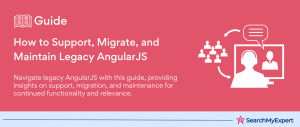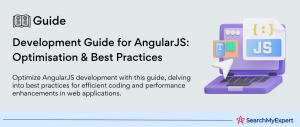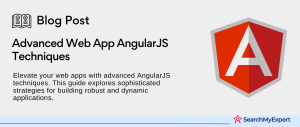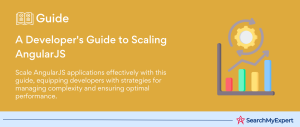Understanding Events in AngularJS
AngularJS, a structural framework for dynamic web apps, simplifies both development and testing by providing a framework for client-side model-view-controller (MVC) and model-view-viewmodel (MVVM) architectures. A critical aspect of making web applications interactive is the use of events. Events in AngularJS play a pivotal role in responding to user inputs by executing specified logic. This guide will delve into the nature of events within AngularJS, their significance in web applications, and the various types of events you can harness to create responsive and interactive user experiences.
What are Events and Their Role in Web Applications?
Events are actions or occurrences that happen within the system you’re working with; in the context of web applications, these are typically user actions like clicks, mouse movements, key presses, or any significant occurrence that the system can detect. In AngularJS, events are fundamental to the interactive nature of web applications. They allow the application to respond to user inputs in real time, making the application feel more dynamic and responsive.
For instance, when a user clicks a button, an event is triggered, which AngularJS can respond to by executing a function or changing the data bound to the view. This responsiveness is crucial for creating an engaging user experience, as it enables immediate feedback to the user’s actions without needing to reload the page.
Types of Events in AngularJS
AngularJS provides support for a wide range of events, which can be categorized into several types. These event types enable developers to handle almost any user interaction imaginable. The primary categories include:
Mouse Events
Mouse events are triggered by actions involving a mouse device. AngularJS supports several mouse events, including:
- click:
Triggered when the mouse clicks on an element. - dblclick: Triggered when the mouse double-clicks on an element.
- mouseenter: Triggered when the mouse pointer enters the element.
- mouseleave: Triggered when the mouse pointer leaves the element.
These events are essential for creating interactions that depend on mouse actions, such as opening a menu, displaying additional information, or initiating animations.
Keyboard Events
Keyboard events occur due to user interactions with the keyboard. They include:
- keydown: Triggered when a key is pressed down.
- keyup: Triggered when a key is released.
- keypress: Triggered when a key is pressed and released.
Keyboard events are vital for handling inputs in forms, creating keyboard shortcuts, and enhancing accessibility.
DOM Events
DOM events are related to the Document Object Model (DOM) and include:
- change: Triggered when the value of an element changes (commonly used with input elements).
- focus: Triggered when an element gains focus.
- blur:
Triggered when an element loses focus.
These events are crucial for form validations, changing styles based on focus, and other DOM manipulation tasks.
Custom Events
AngularJS allows developers to define their own custom events using the $emit, $broadcast, and $on methods. Custom events are beneficial for creating highly specific interactions that are not covered by the standard events. They enable communication between different components and layers of the application, making them essential for complex application architectures.
- $emit: Propagates the event upwards through the scope hierarchy.
- $broadcast:
Propagates the event downwards to child scopes. - $on Listens for the specified event.
By leveraging these event types, developers can create rich, interactive web applications that respond to users’ actions in versatile and intuitive ways. Understanding and utilizing events in AngularJS is foundational to developing web applications that offer engaging and responsive user experiences.
Event Listening Mechanisms in AngularJS
In AngularJS, making your web application interactive and responsive to user actions is achieved through various event-listening mechanisms. These mechanisms are crucial for capturing and responding to events such as clicks, form submissions, and changes in data models. This section explores the built-in directives AngularJS provides for event handling, the general syntax for setting up event listeners, and how to implement custom event bindings using $on.
Utilizing Built-in Directives for Event Handling
AngularJS simplifies event handling by offering built-in directives that allow developers to attach event listeners directly in the HTML, making the code more intuitive and cleaner. Let’s look at some of these directives:
ng-click
This directive is a straightforward way to execute a function when the user clicks on an element. It’s commonly used for buttons and links to trigger actions within the application.
ng-submit
Used within forms, ng-submit triggers a function when the form is submitted. This directive helps in handling form submissions without the need for traditional JavaScript event listeners, facilitating data processing and validation seamlessly.
Event Listener Syntax and Parameters
In AngularJS, the syntax for attaching event listeners typically involves specifying the event directive within the HTML element and assigning a function defined in the scope. This function can take parameters, such as the event object, to provide more control and flexibility over the event-handling logic.
The event object, which is often passed as a parameter to the event handling function, contains valuable information about the event, such as the target element, the type of event, and other event-specific data. This allows developers to write more dynamic and context-aware event-handling functions.
Custom Event Bindings with $on
Beyond the built-in event handling directives, AngularJS provides a mechanism for custom event bindings through the $on service. This feature is used to listen for custom events or events broadcasted by other parts of the application. $on enables components to communicate with each other effectively, making it possible to execute specific logic when certain conditions or events occur within the application.
Event Handling Functions in AngularJS
In AngularJS, event-handling functions are the backbone of interactive web applications, allowing developers to define how the application should respond to various user actions. This section focuses on the best practices for defining and structuring event handler functions, accessing event object properties and data, and preventing default event behavior to create a seamless user experience.
Defining and Structuring Event Handler Functions
Event handler functions in AngularJS are defined within the scope of a controller or a directive, providing a clear structure for managing application logic in response to events. These functions are typically assigned to scope properties and referenced directly in the HTML through directives such as ng-click, ng-submit, and ng-change.
To ensure maintainability and readability:
- Keep Functions Concise: Aim to make your event handler functions perform a single action or a series of closely related actions. If the function becomes too complex, consider breaking it down into smaller, reusable functions.
- Use Descriptive Names: Name your event handler functions descriptively to convey their purpose or the specific event they handle, such as saveFormData or toggleMenuVisibility.
- Organize Logically:
Group related event handler functions together within your controller or directive to improve the organization. This approach helps in understanding the component’s behavior and maintaining the code.
Accessing Event Object Properties and Data
The event object in AngularJS, often passed as a parameter to the event handling function, contains properties and data related to the event, such as the target element (event. target), the type of event (event. type), and custom data attached to the event.
To effectively use this information:
- Explore the Event Object: Familiarize yourself with the properties of the event object relevant to your application’s needs. For instance, event.target.value can be invaluable when handling form input changes.
- Passing the Event Object: When using AngularJS directives like ng-click, you can pass the $event object to your handler function to access these properties directly in your JavaScript code.
- Utilize Event Data: Use the data contained within the event object to make dynamic decisions in your application, such as filtering a list based on a user’s input or navigating to a different view based on a clicked element.
Preventing Default Event Behavior
There are scenarios where the default behavior of an event is not desired. For example, submitting a form traditionally causes the page to reload, which is not always suitable for single-page applications (SPAs) built with AngularJS.
To prevent default event behavior:
- Use event.preventDefault(): Within your event handler function, call event.preventDefault() to stop the event from triggering its default action. This is particularly useful in ng-submit handlers to prevent form submissions from reloading the page.
- Conditional Prevention:
Sometimes, you may want to prevent the default behavior only under certain conditions. In such cases, use conditional logic within your event handler to decide whether to call an event.preventDefault() based on the application’s state or user input.
Event Propagation and Bubbling in AngularJS
Event propagation and bubbling are fundamental concepts in web development that describe how events travel through the DOM (Document Object Model) from the target element where the event occurred up to the root of the document. Understanding these concepts is crucial in AngularJS to effectively manage event handling, especially when dealing with nested elements and complex application structures. This section explores the event flow within AngularJS, focusing on the $event object and techniques for capturing or stopping event propagation.
Understanding the Event Flow in AngularJS
In AngularJS, as in standard web development practices, events follow a specific flow through the DOM. This flow can be divided into two main phases:
- Capturing Phase:
The event starts from the root of the document and travels down to the target element. This phase is useful for intercepting an event before it reaches its intended target. - Bubbling Phase: After reaching the target element, the event then bubbles up from the target element back to the root of the document. This is the default phase for most event handlers and allows for a more generic handling of events.
The $event Object and Controlling Event Propagation
AngularJS provides the $event object as a way to interact with the native event object within your event handler functions. This object includes all the standard properties and methods you would expect from the native JavaScript event object, such as stopPropagation() and preventDefault().
Capturing and Stopping Event Propagation
In scenarios where you need to prevent an event from continuing its journey either up (bubbling) or down (capturing), AngularJS allows you to call specific methods on the $event object:
- $event.stopPropagation():
This method stops the event from propagating further. It is particularly useful in nested structures where an event on a child element should not trigger handlers on parent elements. For example, if you have a click event on a list item and another click event on the list itself, calling stopPropagation() on the list item’s event handler prevents the list’s click event handler from being triggered. - Use Case Specificity:
It’s important to use stopPropagation() judiciously, as stopping the propagation of events can have unintended consequences, such as preventing other event handlers from executing. This method should typically be used when you’re certain that the event should not be handled beyond the current target.
Debouncing and Throttling Events in AngularJS
In web applications, certain events such as scrolling, resizing, or keypresses can trigger functions repeatedly and rapidly, potentially leading to performance issues. To mitigate these problems, debouncing and throttling are two effective techniques used to optimize performance for frequently triggered events. This section explores the differences between debouncing and throttling, their implementation strategies, and how they can be applied within AngularJS applications to enhance user experience and application performance.
Optimizing Performance for Frequently Triggered Events
Performance optimization is crucial in creating responsive and efficient web applications. When events are triggered too frequently:
- Performance Issues Arise:
Excessive function calls can lead to sluggish interfaces, delayed responses, and even browser crashes in severe cases. - Resource Consumption Increases:
Unnecessary computations and DOM manipulations consume valuable system resources, impacting the overall performance.
Debouncing vs. Throttling Techniques
While both techniques aim to optimize performance, they do so in slightly different ways:
Debouncing
Debouncing ensures that a function is only executed after a certain amount of time has passed without the event being triggered again. This is particularly useful for events like keystrokes or input field validations, where the action should only happen after the user has stopped typing.
- Use Case:
Debouncing is ideal for search input fields where you want to wait for the user to finish typing before making an API call to fetch the search results.
Throttling
Throttling, on the other hand, limits the execution of a function to no more than once every specified amount of time, regardless of how many times the event is triggered. This is useful for handling events like scrolling or window resizing, where you want to ensure that the event handler is called at a steady rate.
- Use Case:
Throttling is useful for scroll events where you want to update the UI or load content dynamically as the user scrolls, but without overwhelming the browser by doing it too frequently.
Broadcasting and Emitting Events in AngularJS
AngularJS provides a robust communication mechanism between controllers, directives, and services through the use of events. This system is particularly useful for managing data flow and signaling across different parts of an application. The $broadcast, $emit, and $on methods facilitate these interactions, allowing for a flexible and decoupled approach to handling application-wide events. Additionally, the $rootScope service can be used to implement custom events that transcend scope hierarchies, further enhancing the capability to communicate across disparate components. This section explores how to utilize these methods for effective communication between controllers and view elements in AngularJS applications.
Communicating Between Controllers and View Elements
In AngularJS, communication between controllers, directives, services, and view elements is essential for building dynamic and interactive web applications. The framework’s event system plays a crucial role in this communication, enabling the application components to remain loosely coupled while still interacting efficiently.
Using $broadcast, $emit, and $on for Data Flow
These methods are central to AngularJS’s event-based communication system:
- $broadcast:
This method is used to dispatch an event downwards to all child scopes and their descendants, allowing communication from parent controllers to child controllers or directives. It is ideal for notifying nested components of changes or events that affect the application’s state. - $emit:
In contrast, $emit sends an event upwards through the scope hierarchy, from child scopes to their parents, all the way up to the $rootScope. This method is useful for communicating state changes from child components to parent components or the application at large. - $on: To listen for events, whether broadcasted with $broadcast or emitted with $emit, the $on method is used. It allows controllers, directives, and services to react to events, enabling dynamic data flow and behavior within the application.
Implementing Custom Events with $rootScope
For events that need to be accessible application-wide, regardless of the scope hierarchy, $rootScope can be employed to broadcast or emit custom events. This global scope serves as the ultimate parent scope, making events dispatched via $rootScope accessible throughout the entire application.
- Global Event Dispatch:
By using $rootScope to $broadcast or $emit events, you can ensure that these events are available to all controllers and directives, facilitating a global communication channel. - Custom Event Implementation: Implementing custom events with $rootScope typically involves broadcasting an event with a unique name and optionally passing data as arguments. Listeners can then be set up using $on in any part of the application to respond to these events, making it an effective way to manage complex data flows and interactions across components.
Best Practices and Tips for Event Handling in AngularJS
Effective event handling is pivotal for creating responsive, maintainable, and accessible AngularJS applications. As we’ve explored various aspects of event handling, from listening mechanisms to optimizing performance and enhancing communication through broadcasting and emitting events, it’s crucial to consolidate these insights into actionable best practices and tips. This section highlights key strategies for organizing event handlers, debugging common issues, and ensuring your AngularJS application is accessible, including keyboard navigation.
Organizing and Structuring Event Handlers
- Modularity and Reusability: Aim to keep your event handlers modular and reusable. Break down complex handlers into smaller functions that can be easily tested and reused across different parts of your application.
- Naming Conventions:
Use clear and descriptive naming for your event handlers. Names like onUserLogin or handleFormSubmit instantly convey the purpose of the function, improving code readability. - Scope Organization: Organize your code logically within controllers and services. Group related event handlers together, and leverage AngularJS services for shared logic, reducing duplication and fostering a cleaner codebase.
Debugging and Troubleshooting Common Event Handling Issues
- Console Logging:
Use console.log judiciously to print out event data and variables within your event handlers. This simple technique can help you understand the flow of data and identify where things might be going wrong. - AngularJS Developer Tools: Take advantage of AngularJS-specific developer tools, such as the AngularJS Batarang extension for Chrome, to inspect scopes, watch expressions, and analyze performance issues.
- Check for Typos in Event Names: A common mistake is typos in directive names or event names, leading to non-functioning event handlers. Double-check your code for any misspellings.
Considerations for Accessibility and Keyboard Navigation
- Ensure Keyboard Accessibility:
Make sure that all interactive elements are accessible through keyboard navigation. Use the tabindex attribute to control the sequence of keyboard focus and include keyboard event handlers (ng-keydown, ng-keyup) for actions. - Semantic HTML:
Use semantic HTML elements (e.g., <button>, <a>, <form>) for interactive content. These elements come with built-in keyboard accessibility, which can be enhanced with AngularJS event directives. - ARIA Roles and Attributes:
Incorporate ARIA (Accessible Rich Internet Applications) roles and attributes to improve screen reader support. AngularJS applications can dynamically update ARIA attributes in response to events, improving the accessibility of dynamic content. - Test with Screen Readers:
Regularly test your application with screen readers and keyboard navigation to ensure all users can access and interact with your content effectively.
Conclusion
Throughout this detailed exploration of event handling in AngularJS, we’ve delved into the intricacies of managing and responding to user interactions within the framework. From understanding the basics of AngularJS events, through optimizing performance with debouncing and throttling, to enhancing application communication with broadcasting and emitting events, this guide has covered essential techniques and best practices.
Organizing and structuring event handlers effectively ensures that your code remains clean, maintainable, and scalable. Debugging tips and accessibility considerations further empower developers to create applications that are not just functional but also inclusive and accessible to all users.
Navigate the future of web development with Angular JS Development Service Agencies.
Table of Contents
Toggle






